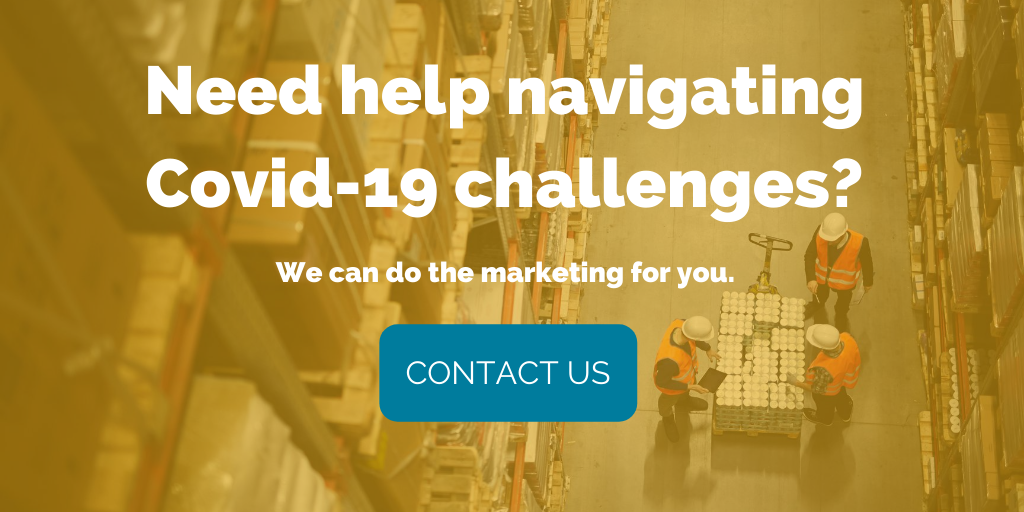Home
SUPPLY CHAIN MARKETING More leads. More business. Build brand authority and your sales pipeline Grow your supply chain business with a tailored B2B marketing strategy designed by an agency of industry experts. Here's what we do Our services Let’s grow your...
Stop hibernating: You’re missing out on company blog benefits
The benefits of a B2B blog are too important to overlook. Plus: Three companies that excel at content creation. If your company blog has gone the way of the bears in winter, there is good reason to bring it back to life. That stale page on your website is more...
Key step to moving beyond survival mode: Revising B2B buyer personas
Company priorities have shifted in the wake of Covid-19. Revising B2B buyer personas is important to reaching them on the right terms.
The fallout of Covid-19 indefinitely altered the supply chain. Even months after the first shockwave, companies are adjusting to new circumstances that bring new priorities when they look for partnerships and make purchasing decisions.
If your organization went through a first round of marketing plan updates back in March to reflect the new reality, time has come to take a second look at revising B2B buyer personas. But we realize time is of the essence. Few companies have days to spare for the rigor of examining every detail of what makes a target audience tick.
Yet, it pays to get the personas just right. If your messaging is not calibrated to their current needs and pain points, the effort may be largely wasted.
An example:
Let’s say you offer an inventory solution and your marketing pitch and channels remain the same pre- and post Covid-19 even as shippers, carriers, and logistics managers say there may be a paradigm shift when it comes to future sourcing and inventory management. The fact is you may be missing an optimal opportunity to position your product in a whole new light that resonates with current buyers and also has the potential to reach an untapped audience.
5 questions that will help you revise B2B buyer personas
So, what is the quick route to revising B2B buyer personas to extract the most important details? It really comes down to nailing the answers to five key questions — while avoiding getting bogged down in trivia that has no bearing on how the persona relates to your product offering or service (leave the search for the perfect persona pic for another time).
1. What are the top three priorities of your buyer persona?
This question relates to the problems or objectives that the buyer dedicates time, budget, and political capital too. Although many end-users of supply chain solutions have been able to step off the rollercoaster ride of the past few months, some will be dealing with bumpy patches for the unforeseeable future while others are adjusting to a brand-new business landscape. A retailer that pre-Covid-19 was focused on speeding up deliveries may now be consumed with dealing with suppliers to secure inventory.
Question to ask yourself: How can you align your product/service with the new priorities of your target audience?
2. How does the buyer identify success?
Take a look at the tangible or intangible metrics and rewards that the buyer uses to measure success. Is the buyer hoping his or her contributions will lead to a promotion? Is the buyer focused on acquiring a certain number of clients, improving internal organization, or generating revenue growth? If an IT-manager before Covid-19 tried to demonstrate cost savings to upper management, focus may now have switched to successfully implementing cross-department workflows.
Question to ask yourself: Can your product/service play a role in helping the buyer achieve the desired success?
3. What are the challenges the buyer is trying to overcome?
The answer to this question has likely changed significantly for your buyers. A shipper that just a few months ago faced a predictable environment may now deal with a shortage of cross-docking facilities in addition to shipping restrictions that change across state lines.
Questions to ask yourself: Does your product or service fit into your buyer’s new reality? How can you alleviate the challenges?
4. What does the buyer’s journey look like?
Again, anticipate considerable adjustments. With the cancellation or postponement of trade shows that many view as one of the most important opportunities to network and connect, your buyers will have to take the search for solutions elsewhere. Since technology and service providers rank content assets as the most effective lead-generating tactic (trade shows come in a close second), it is not a far-fetched guess that buyers will seek out digital channels to research and initiate contact. In the process of revising B2B buyer personas, identify where your target audience is spending their time.
Question to ask yourself: Which channels will be the most effective in reaching potential buyers?
5. What decision criteria does the buyer use?
How will the buyer compare and contrast aspects or your product or service with the alternatives? In light of the pandemic impact, budgetary constraints could play a larger role than usual. The tendency to “make do” with current solutions is also a factor that many marketers will run into. What holds true for your buyers?
Question to ask yourself: Based on the decision criteria, how can you preempt questions that may come up?
Final word
With the help of your sales team, market research, and — ideally — interviews with actual buyers as well as prospects who eventually picked a competitor, you can craft relevant, up-to-date B2B buyer personas.
Knowing exactly who your audience is, what their goals and challenges are, where they look for information, and how they make purchasing decisions is the foundation of any marketing strategy. And when circumstances change so drastically as in recent months, revising B2B buyer personas is a crucial step to remain effective and, in the end, grow stronger.
Read more:
Cancellations call for trade show contingency plans (It’s urgent)
Supply chain marketing during Covid-19, the risk of cutting back
Covid-19 messaging strategy for supply chain companies: Getting the basics right

Cancellations call for trade show contingency plans (It’s urgent)
With a main lead-generating source canceled or postponed, trade show contingency plans take on increased importance.
The Supply Chain USA 2020 summit in Chicago is a flagship event. Considered a must-attend gathering for strategic decision-making, it draws 1,000 supply chain and logistics leaders for three “unmissable days.”
For executives like Tom Schmitt, chairman and CEO of Forward Air Corp., it is the type of event that generates so many “relevant conversations” that he says it is like getting the value of nine business trips for the price of one.
This year, though, those who planned to head to Supply Chain USA, June 16-18, will need to start working on their trade show contingency plans. The fallout of the coronavirus pandemic has forced EFT, the organizer, to postpone and a new date has yet to be determined.
And — as you have likely experienced yourself — the summit attendees are hardly alone. Within weeks of the Covid-19 outbreak, 1 million people saw their corporate event plans scuttled. MODEX in Atlanta, Ga., in early March, turned out to be one of the last hurrahs for supply chain professionals — half of the pre-registered attendants were no-shows — before cancellations and postponements turned the supply chain conference circuit on its head.
Now, supply chain pros wonder, “What’s next?”
Covid-19 forces domino of cancellations, postponements
A look at this list gives you an idea of the impact: (Check event websites for the latest info)
[table id=2 /]
Trade show contingency plans need to fill big lead generation gap
For supply chain and logistics companies, the cancellations and uncertainty surrounding the postponed shows are no small matters. Trade shows are one of the largest lead generators for B2B demand generation.
Technology and service providers spend an average of 11% of the marketing programs budget on third-party tradeshows, according to the Gartner 2019 Tech Marketing Benchmarks Survey. And the investment seems to be paying off, as 18% of the same companies rank events as the best-performing calls-to-action of marketing-qualified leads, second only to content assets.
Another survey, by MarketingCharts, found software and technology companies cite events as the most effective demand-generation tactic for attracting top-of-the-funnel qualified leads.
In other words, the need to develop trade show contingency plans is quite urgent.
Trend watch: What some companies are doing
So, what actions have some of your peers taken to date to make up for the loss of face-to-face networking?
Some trends are emerging, including:
E-learning: To ensure business continuity while adhering to stay-at-home policies, DC Velocity notes e-learning has taken on increased significance. The establishment of interactive online courses allows companies to conduct specialist training sessions on complex topics that attendees can complete at their own pace. (E-learning is usually a time-consuming and fairly costly endeavor but can serve its purpose when the audience already has an invested interest in the company. For quick engagement, we recommend webinars.)
Dropped subscription fees: On-premise platforms that run on business servers are not conducive to remote work — and vendors of cloud-based supply chain software have seized the market opening. For the sake of lead generation, a range of companies have dropped subscription fees, offering free access to products like transportation management, route optimization, last-mile visibility, and remote robotic operations. One example: InMotion Global, Inc., has made its cloud-based platform, AscendTMS, available at no cost to any company needing help for 30 days.
Quick actions matter
The fact more people are spending more time than usual on their computers provide an opening for companies that can leverage trade show contingency plans. Gartner, for one, advises teams must be prepared to quickly pivot marketing strategy and build campaigns to address this shift.
Immediately after a cancellation or postponement, actions may include:
- Replace all scheduled event meetings with online meetings within 24 hours.
- Create a webinar series that homes in on the key messages you had planned to convey.
- Develop a series of video posts for the company blog that leverage the materials you prepared for speaking sessions and in-booth presentations.
- Promote all content on social media (Video content generates better engagement).
- Combine paid advertising and account-based marketing to target potential buyers.
- Inquire whether there are any opportunities to use the digital channels of the show host for promotions.
Stay relevant — at a distance
Although it may feel like unchartered territory, you really can have relevant conversations online. Base your opening statement on a trade show contingency plan.

